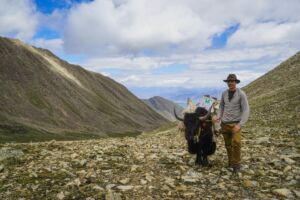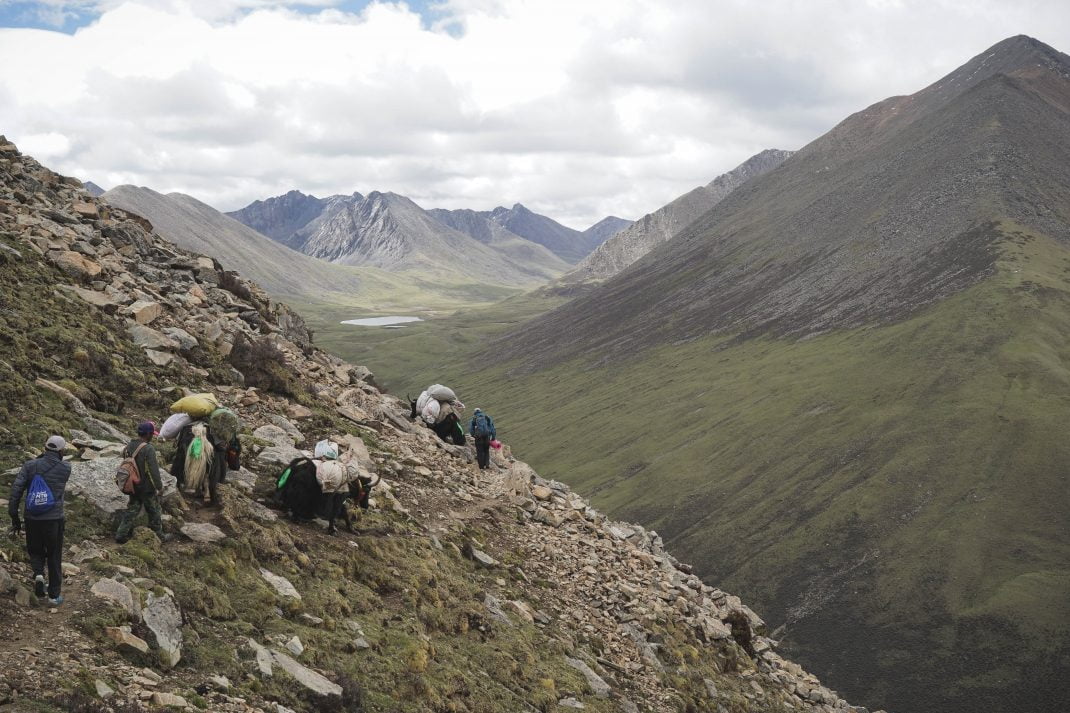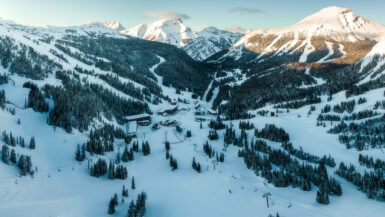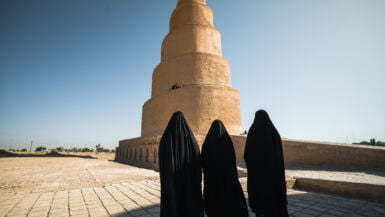Ganden and Samye Monastery, Tibet
The high altitude mountain trails bend and twist their way above the clouds. From one vast starkly beautiful valley to another, the trail takes you by frigid glacial lakes and impossibly high mountain peaks. Sometimes the valleys are dotted with yaks and their owners who live in primitive black tents made of yak wool, but for the most part its just you and raw nature. With its deeply spiritual, and intensely alluring culture; this is Tibet at its most authentic. Hiking between these two monasteries is one of Tibet’s greatest passages, a journey that has been preformed for centuries. Prepare to connect deeply with Tibet and its history as you follow in the footsteps of countless Tibetan pilgrims and explorers before you!
Getting to Tibet
There are only a few ways to get to Tibet. With the bus from Sichuan off limits to foreigners you are left to either fly or take the overland train to Tibet.

I opted for the train from Beijing to Lhasa. The journey took a whopping 42 hours, where we passed by shimmering sand dunes, grasslands as far as the eye can see, and stupefying mountain scenery. The railway is a marvel onto itself! Dubbed as the worlds highest train journey, the tracks are heated by a water system so that they do not freeze over. Oxygen is administered into the train as well so its occupants don’t suffer from acute mountain sickness.
The train journey being almost less than half the price of flying is well worth it, and I highly recommend it.
Permits and Restrictions for Tibet
Ask anyone about traveling to Tibet and you are usually left with the answer “the permits are to difficult and expensive”. While this was the case in the past, the permits for Tibet have now been relaxed and can easily be obtained from your tour company.

Unfortunately, independent travel to Tibet is still currently forbidden by non Chinese nationals. You can be without a guide within the confines of Lhasa, Tibet’s Capital City, but other than that you must be accompanied by a guide at all times.
These permits vary from region to region, but as I stated above your company can arrange all of these with only a copy of your passport, and Chinese visa.
Ganden Monastery
In the early hours of the morning my guide Tenzin met up with me so we could arrange the last tools for our exhibition into the Himalayas. After picking up food and propane we were off to the starting point of the famous hike, Ganden Monastery.
Ganden Monastery is huge, and sprawled out over a hill nearby to Lhasa. The countless prayer halls adorned in golden statues of Buddha’s and other wrathful looking deities are a spectacle onto their own.
Follow the wafts of burning juniper alongside countless pilgrims through the maze of cobblestone streets and you can find hidden gems here.
Ganden, founded in 1409 was the first Gelugpa sect monastery. You will instantly notice all of the tall yellow pointed hoods that the monks wear here. The Gelugpa sect is also famed for its deep groaning like chants that the monks preform daily as a ritualistic prayer. If you only have time to visit one of the many monasteries on the outskirts of Lhasa, make it this one due to its historic significance.

Hiking from Ganden to Samye
Stage 1 Ganden to Yama Do – 15km
The hike begins right behind Ganden monastery. As soon as my guide and I were finished exploring Ganden monastery we followed the trail up hill to a set of prayer flags high above the monastery. From here the trail continued on alongside a steep mountain trail.
The views were stunning looking down into the valley. You can see many small Tibetan towns and white stupas dotting the country side. This first day’s hike is not to long, for a strong hiker like me it only took a few hours as the majority of the hike is a slight decline in altitude.
Reaching the village of Yama Do we met with our cook, and yak man. We strapped our supplies atop our four yaks, had a delicious Tibetan lunch and continued towards Tsotup-chu.
Stage 2 Yama Do to Tsotup-chu
From Yama-do it’s a very long climb up. Every kilometre we trudged the grade of steepness increased. The steep climbing mixed with the continued lack of oxygen makes for one tough push if you wish to do the pass in one day.

Halfway up the pass we decided to stop for the night and camp beside some Drokpa nomads. The Drokpa live in black tents made of yak wool and reside in this region for part of the year because there is more grazing available to their animals.

After making camp they invited us in for some warm and salty yak butter tea. Having a foreigner in their tent is an immense pleasure to them, we spent quiet a few hours chatting amongst each other in the smoky tent.
In the morning, we tackled the Shuga-la pass (5250m). A few hours in the altitude really hit. Barely able to walk more than a few steps without pausing to catch your breath made the labour of a slow-paced walk an even greater struggle.
A few hours of pain and finally we reached the summit of the Shuga-la pass. Here you can see all the way down into Lhasa’s valley to the north, and peering down south into the Tsotup-chu Valley you can see a barren land speckled with high alpine lakes.

Stage 3 – Tsotup-chu to Chitu-la
From Shuga-la the rocky trail heads down into the valley. Here the views are the best of the hike so keep your camera ready. Another great tip is to let the yaks go ahead of you, the backdrop of gorgeous scenery with yaks ploughing through the mountain side makes for stunning landscape photography.
The Tsotup Valley is very dramatic. The barren landscape reminisces of a Martian land. Large boulders of red and grey are strewn about while patches of moss provide the only signs of life for miles to come.
In the middle of the valley near to the glacial lake is an isolated shepherd’s hut. Here we stopped for lunch and were given tea from the lone Shepard.
After lunch, it was time to conquer the final pass of the hike. Chitu-la sitting at 5210 m is smaller than its sister pass, but equally as arduous of a climb. Many hikers tend to camp here before taking on Chitu-la, but as my team and I are quite well-versed in the sport we pushed on.

Stage 4 – Chitu-la to Samye Monastery
Finally, after a few more breathless hours we summited Chitu-la. At the top of the pass is a small pretty lake and a pile of inscribed rocks to inform you of your accomplishment. Peering down south from the pass is an emerald blue lake surrounded by piles of large boulders.

The trail continues through here making it difficult as our tired legs wobble on the boulders below. Passed the lake we camped on the first flat piece of land we could find. Apparently during the fall many of the Drokpa nomads camp here for grazing.
In the morning, we said goodbye to our yak man, and cook and continued down the steep trail towards Samye.
These days the road from Samye has breached deep into the valley. Most travelers stop at a town about 15km from Samye and hitch a ride from there as the trail has been replaced with a dusty road. We finished at this town as well.
Samye Monastery
Reaching Samye is a breath of fresh air. Samye is located at a much lower altitude making it have a much warmer climate. There is a few decent hotels and restaurants here as well, making it a good break from the camp food we have been eating for the past few days.

The real highlight of reaching Samye is ending your hike at Samye Monastery. Samye is said to be the first monastery in Tibet. Located in the Yarlung Valley which is also said to be the cradle of Tibetan civilization.
The monastery itself is surrounded by a beautiful garden. Locals walk the exterior, gaining karma while spinning their prayer wheels. It’s a peaceful place and worthy of the last pit stop of the journey.
Inside the monastery you will find halls decorated with ancient Thangka paintings, and hundreds of deity statues. The halls are thick with juniper and butter lamps and the chanting of monks. At the alters you will find human skull cups filled with wine or barley beer given as an offering to the more wrathful deities.
From the roof of the temple we looked over the lush green Yarlung Valley. This was it, the final sweet ending to our epic journey through the Himalayas of Tibet!

Tibetan Highland Tours
My month-long journey across the Tibetan Plateau was not just made possible, but made incredible by Tibetan Highland Tours. They got me access to sights rarely seen by many. I fell in love with Tibet because of them.
Tibetan Highland tours also is run by Tibetans, and all their guides are Tibetan. This is essential to your trip here. Only Tibetans know this land and culture! They also support many schools in the region for Tibetans. All round they are an incredible company. Check them out here!























Great post and advice. These are really great tips to follow. Thanks for sharing valuable tips. – shirdi flight package and mumbai flight package from chennai
https://myshirditrip.com/shirdi-and-mumbai-flight-package-from-chennai.html